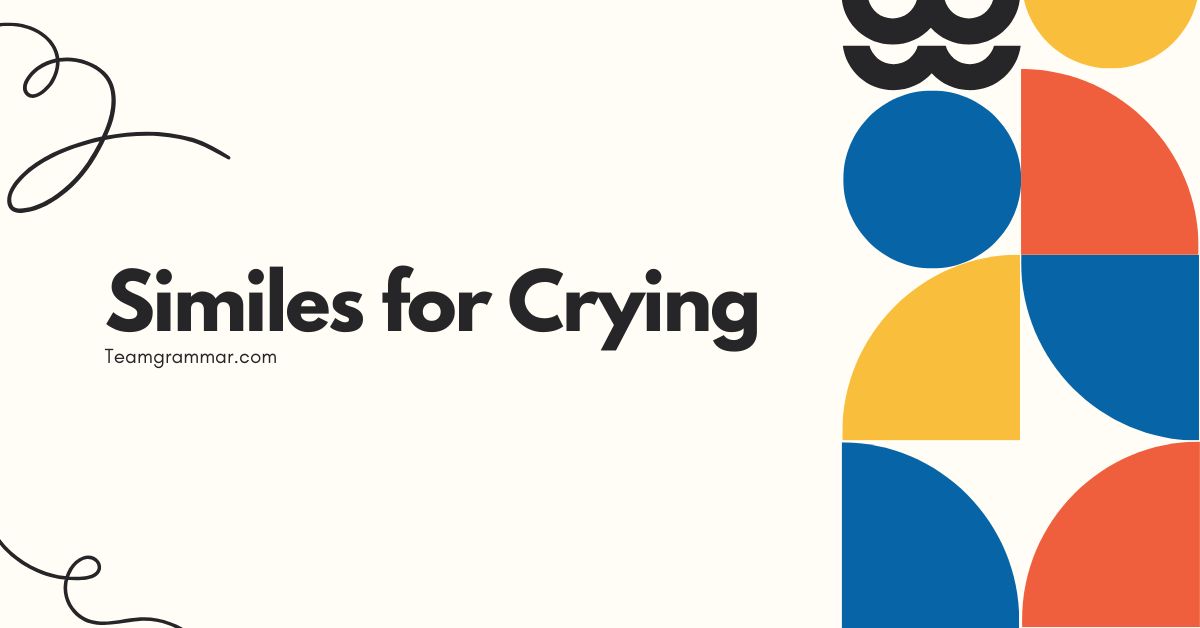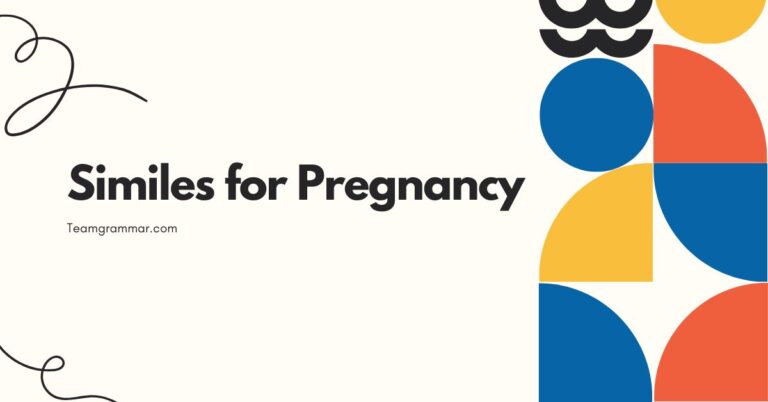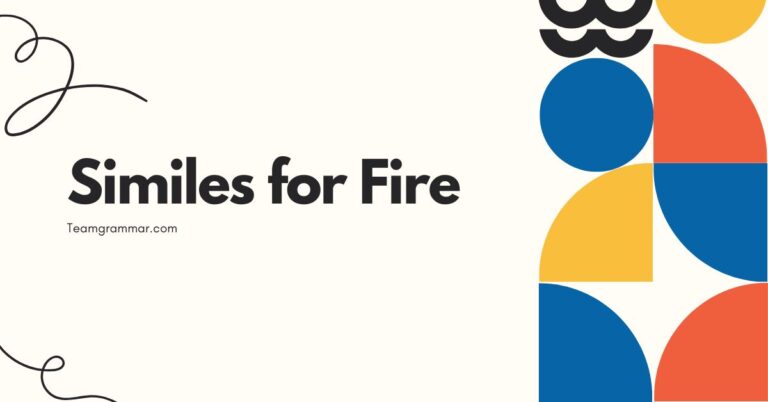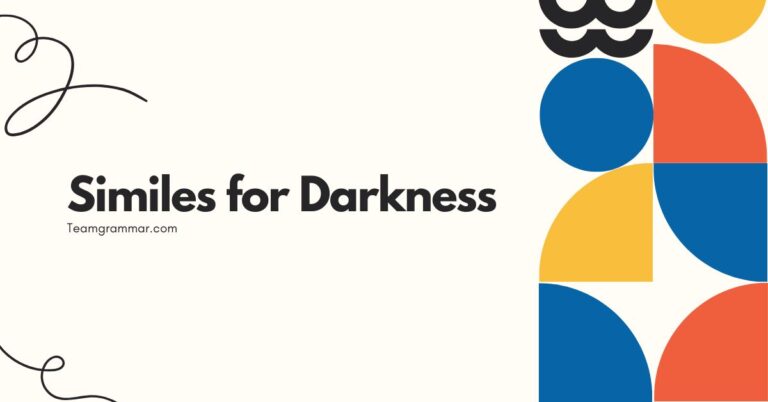37 Similes for Crying: Mastering Figurative Language
Understanding similes is crucial for enhancing your descriptive writing and comprehension skills. Similes, by comparing one thing to another using “like” or “as,” add depth and vividness to language.
This article focuses specifically on similes related to crying, exploring their structure, types, and effective usage. Whether you’re a student, writer, or language enthusiast, mastering these similes will significantly improve your ability to express emotions and imagery with greater precision and impact.
This article will equip you with the knowledge and examples needed to confidently incorporate similes for crying into your writing and speech.
Table of Contents
- Introduction
- Definition of Simile
- Structural Breakdown of Similes
- Types of Crying Similes
- Examples of Similes for Crying
- Similes Comparing Intensity
- Similes Comparing Sound
- Similes Comparing Appearance
- Similes Comparing Cause
- Usage Rules for Similes
- Common Mistakes with Similes
- Practice Exercises
- Advanced Topics in Similes
- Frequently Asked Questions
- Conclusion
Definition of Simile
A simile is a figure of speech that directly compares two different things, explicitly using the words “like” or “as.” The purpose of a simile is to enhance the description of something by relating it to something else that is more familiar or vivid. Similes are essential tools in both writing and everyday conversation, allowing us to paint clearer pictures and convey deeper meanings through comparison.
Similes fall under the broader category of figurative language, which includes metaphors, personification, and hyperbole. While a metaphor directly equates two things (e.g., “He is a lion”), a simile only suggests a similarity (e.g., “He is bravelikea lion”).
This explicit comparison makes similes generally easier to identify and understand, especially for language learners.
The function of a simile is to create a more evocative and relatable image in the mind of the reader or listener. By drawing a comparison to something familiar, similes can make abstract concepts more concrete and emotional experiences more accessible.
In the context of crying, similes can help to express the intensity, sound, appearance, or cause of tears with greater precision and emotional impact.
Structural Breakdown of Similes
The basic structure of a simile involves three key components: the subject, the linking word (“like” or “as”), and the object of comparison. Understanding these elements is crucial for constructing effective and meaningful similes.
Thesubjectis the thing being described. In the context of our article, this will usually be related to crying – the tears, the person crying, or the act of crying itself.
For example, in the simile “Her tears flowedlikea river,” the subject is “her tears.”
Thelinking wordis the element that explicitly signals the comparison. This is either “like” or “as.” The choice between “like” and “as” is often a matter of stylistic preference, although “as” can sometimes imply a greater degree of similarity or equivalence.
For instance, “He criedasif his heart would break” suggests a more profound emotional distress than “He criedlikehe was sad.”
Theobject of comparisonis the thing to which the subject is being compared. This element provides the reader or listener with a reference point for understanding the subject.
In the example “Her tears flowedlikea river,” the object of comparison is “a river,” which helps to convey the volume and continuous flow of her tears.
Here’s a table summarizing the structural components of a simile:
| Component | Description | Example |
|---|---|---|
| Subject | The thing being described | Her tears |
| Linking Word | “Like” or “as” | Like |
| Object of Comparison | The thing to which the subject is compared | A river |
Understanding this structure allows you to create your own similes effectively. By choosing appropriate objects of comparison, you can convey specific aspects of crying, such as its intensity, sound, or appearance, with greater clarity and impact.
Types of Crying Similes
Similes for crying can be categorized based on the aspect of crying they emphasize. This categorization helps to understand the nuances of expressing emotions through figurative language.
Here are some common types of crying similes:
Similes Comparing Intensity
These similes describe the degree or force of crying. They often use comparisons to powerful natural phenomena or intense emotional states to convey how deeply someone is crying.
Similes Comparing Sound
These similes focus on the sounds associated with crying, such as sobbing, weeping, or wailing. They may compare these sounds to other noises that evoke similar feelings or sensations.
Similes Comparing Appearance
These similes describe the physical appearance of someone who is crying, including the redness of their eyes, the flow of tears, or the contorted expression on their face. They often use comparisons to visual elements that create a vivid image of distress.
Similes Comparing Cause
These similes indirectly describe the crying by comparing the cause or the feeling that leads to it to something else. They focus on the emotional or situational triggers of crying, rather than the act of crying itself.
Examples of Similes for Crying
To illustrate the different types of similes for crying, here are several examples organized by category. Each example aims to provide a clear understanding of how these similes can be used effectively.
Similes Comparing Intensity
These similes focus on the depth and force of the crying, often using vivid imagery to convey the overwhelming nature of the emotion.
| Simile | Explanation |
|---|---|
| She cried like a baby. | Implies uncontrolled and loud crying, similar to an infant’s distress. |
| He wept like a willow. | Suggests a gentle, continuous flow of tears, reminiscent of a willow tree’s drooping branches. |
| They sobbed as if their hearts would break. | Conveys intense emotional pain and grief. |
| She bawled like a wounded animal. | Implies a loud, unrestrained, and painful cry. |
| He cried like a storm was brewing inside him. | Suggests a build-up of intense emotion finally erupting in tears. |
| Her tears flowed like a river. | Indicates a large, continuous, and unstoppable flow of tears. |
| He cried as if his world was ending. | Conveys a sense of utter devastation and loss. |
| She wept like a fountain overflowing. | Suggests a profuse and continuous outpouring of tears. |
| He sobbed like a child lost in the dark. | Implies feelings of fear, helplessness, and vulnerability. |
| They cried as if their souls were aching. | Conveys deep, profound emotional pain. |
| Her tears fell like heavy rain. | Indicates a substantial and impactful outpouring of tears. |
| He cried like a dam had burst. | Suggests a sudden and overwhelming release of pent-up emotions. |
| She wept as if her spirit was crushed. | Implies a feeling of utter defeat and despair. |
| He cried like all the sadness in the world had settled upon him. | Conveys an immense burden of grief and sorrow. |
| Her sobs echoed like thunder in the silence. | Suggests a powerful and disruptive expression of grief. |
| He cried as though his heart was being ripped apart. | Conveys intense emotional pain and suffering. |
| She wept like a parched land welcomes rain. | Suggests a desperate and overwhelming need for emotional release. |
| He cried as if trying to wash away all his regrets. | Implies deep remorse and a desire for redemption. |
| Her tears streamed down like molten lava. | Suggests a burning, intense, and unstoppable flow of tears. |
| He cried like a lone wolf howling at the moon. | Conveys feelings of isolation, sorrow, and longing. |
| She cried as if her dreams had shattered into a million pieces. | Implies a profound sense of loss and disappointment. |
| He wept like a forgotten statue in the rain. | Suggests feelings of neglect, loneliness, and sorrow. |
| Her tears gushed forth like a geyser erupting. | Indicates a sudden, powerful, and uncontrollable release of emotion. |
Similes Comparing Sound
These similes describe the sounds associated with crying, such as sobs, whimpers, and wails, often comparing them to other sounds that evoke similar emotions or sensations.
| Simile | Explanation |
|---|---|
| Her sobs were like the whimpering of a lost puppy. | Suggests a soft, pitiful, and vulnerable sound. |
| His cries echoed like the wail of a siren. | Implies a loud, piercing, and distressing sound. |
| Her weeping sounded like the rustling of dry leaves. | Conveys a soft, melancholic, and fragile sound. |
| His sobs were as broken as a shattered window. | Suggests fragmented, sharp, and painful sounds. |
| Her cries were like the mournful call of a distant owl. | Implies a lonely, haunting, and sorrowful sound. |
| His weeping sounded like the gentle patter of rain on a roof. | Conveys a soft, soothing, yet melancholic sound. |
| Her sobs were like the creaking of an old, wooden ship. | Suggests a strained, labored, and aged sound. |
| His cries echoed like the howling of the wind through a canyon. | Implies a vast, echoing, and desolate sound. |
| Her weeping sounded like the soft strumming of a sad guitar. | Conveys a gentle, melodic, yet sorrowful sound. |
| His sobs were as hollow as the sound of an empty well. | Suggests a deep, empty, and echoing sound. |
| Her cries were like the piercing shriek of a tea kettle. | Implies a high-pitched, sharp, and startling sound. |
| His weeping sounded like the distant rumble of thunder. | Conveys a low, ominous, and foreboding sound. |
| Her sobs were like the gentle lapping of waves against the shore. | Suggests a rhythmic, soothing, yet melancholic sound. |
| His cries echoed like the mournful song of a whale. | Implies a deep, resonant, and sorrowful sound. |
| Her weeping sounded like the soft sighing of the wind. | Conveys a gentle, breathy, and melancholic sound. |
| His sobs were as stifled as a whisper in a crowded room. | Suggests a muted, suppressed, and barely audible sound. |
| Her cries were like the grating sound of nails on a chalkboard. | Implies an unpleasant, irritating, and jarring sound. |
| His weeping sounded like the dripping of water in a dark cave. | Conveys a lonely, echoing, and melancholic sound. |
| Her sobs were like the rustling of silk in a silent room. | Suggests a soft, delicate, and barely audible sound. |
| His cries echoed like the hooting of an owl in the night. | Implies a solitary, haunting, and melancholic sound. |
Similes Comparing Appearance
These similes describe the physical appearance of someone crying, focusing on the redness of their eyes, the flow of tears, and other visible signs of distress.
| Simile | Explanation |
|---|---|
| Her eyes were red like cherries. | Suggests intense redness and inflammation. |
| His face was as blotchy as a watercolor painting. | Implies uneven patches of redness and discoloration. |
| Her tears streamed down like glistening diamonds. | Conveys the beauty and purity of the tears. |
| His eyes were swollen like overripe plums. | Suggests puffiness and discoloration. |
| Her face was as pale as a ghost. | Implies a loss of color due to distress. |
| His tears dripped like honey from a spoon. | Conveys a slow, thick, and continuous flow. |
| Her eyes were as puffy as cotton balls. | Suggests soft, swollen, and tender eyes. |
| His face was as red as a beet. | Implies intense redness and flushing. |
| Her tears sparkled like dew drops on a spiderweb. | Conveys the delicate beauty and fragility of tears. |
| His eyes were as bloodshot as a road map. | Suggests extensive redness and visible veins. |
| Her face was ashen like a statue. | Implies a lifeless and pale complexion. |
| His tears flowed like a waterfall. | Conveys a large, continuous, and powerful flow. |
| Her eyes were as heavy as lead. | Suggests fatigue and difficulty keeping her eyes open. |
| His face was as shiny as a glazed apple. | Implies a wet, reflective surface due to tears. |
| Her tears trickled down like icy rivulets. | Conveys a cold, slow, and continuous flow. |
| His eyes were as dark as a stormy sea. | Suggests deep sorrow and emotional turmoil. |
| Her face was as crumpled as a discarded piece of paper. | Implies a distorted and distressed expression. |
| His tears fell like beads from a broken necklace. | Conveys a scattered, uncontrolled, and precious loss. |
| Her eyes were as glazed over as a porcelain doll’s. | Suggests a vacant, unfocused, and emotionless stare. |
| His face was as flushed as a summer sunset. | Implies a warm, intense, and emotional redness. |
Similes Comparing Cause
These similes indirectly describe crying by comparing its cause or the feeling that leads to it to something else. They focus on the emotional or situational triggers rather than the act of crying itself.
| Simile | Explanation |
|---|---|
| Her grief was like a heavy cloak weighing her down. | Suggests a burdensome and oppressive feeling. |
| His sadness was as deep as the ocean. | Implies an immeasurable and profound sorrow. |
| Her pain was like a sharp knife twisting in her heart. | Conveys intense and agonizing emotional suffering. |
| His despair was as boundless as the sky. | Suggests a limitless and overwhelming sense of hopelessness. |
| Her sorrow was like a dark cloud obscuring the sun. | Implies a pervasive and overshadowing gloom. |
| His anguish was as unbearable as a physical wound. | Conveys intense and agonizing emotional pain. |
| Her heartbreak was like a shattered mirror. | Suggests fragmentation and irreparable damage. |
| His loneliness was as vast as the desert. | Implies a desolate and isolating feeling. |
| Her disappointment was like a deflated balloon. | Conveys a sudden loss of hope and enthusiasm. |
| His regret was as bitter as gall. | Suggests a painful and lingering feeling of remorse. |
| Her loss was like a missing piece of her soul. | Implies a profound sense of incompleteness and emptiness. |
| His fear was as cold as ice. | Conveys a chilling and paralyzing emotion. |
| Her shame was like a brand seared into her skin. | Suggests a permanent and painful mark. |
| His guilt was as heavy as chains. | Implies a burdensome and restrictive feeling. |
| Her betrayal was like a stab in the back. | Conveys a sudden and painful sense of deception. |
| His jealousy was as green as envy. | Suggests a consuming and bitter emotion. |
| Her frustration was like a tangled knot. | Implies a complex and difficult problem to resolve. |
| His anger was as explosive as a volcano. | Conveys a sudden and violent outburst. |
| Her resentment was like a slow-burning fire. | Suggests a simmering and persistent bitterness. |
| His confusion was as thick as fog. | Implies a disorienting and obscuring mental state. |
Usage Rules for Similes
Using similes effectively involves adhering to certain rules to ensure clarity and impact. Here are some guidelines to follow:
- Ensure the comparison is clear: The similarity between the subject and the object of comparison should be easily understood. Avoid obscure or far-fetched comparisons that may confuse the reader.
- Use “like” or “as” correctly: These are the standard linking words for similes. Using other words can blur the line between simile and metaphor.
- Avoid clichés: Overused similes can make your writing sound unoriginal and predictable. Strive for fresh and creative comparisons.
- Consider the context: The appropriateness of a simile depends on the tone and style of your writing. A simile that works well in a poem may not be suitable for a formal essay.
- Maintain consistency: Ensure that the simile aligns with the overall message and theme of your writing. Avoid using similes that contradict or undermine your intended meaning.
Here’s a table summarizing these usage rules:
| Rule | Description |
|---|---|
| Clarity | Ensure the comparison is easily understood. |
| Correct Linking Words | Use “like” or “as” to signal the comparison. |
| Avoid Clichés | Strive for original and creative comparisons. |
| Contextual Appropriateness | Consider the tone and style of your writing. |
| Consistency | Ensure the simile aligns with the overall message. |
Common Mistakes with Similes
Even with a good understanding of similes, it’s easy to make mistakes. Here are some common errors to watch out for:
- Using metaphors instead of similes: Confusing a direct comparison with a comparison using “like” or “as.”
- Creating unclear comparisons: The connection between the two things being compared isn’t evident.
- Overusing similes: Too many similes can make your writing feel cluttered and distracting.
- Mixing metaphors and similes: Inconsistently using both figures of speech in the same passage.
Here are some examples of common mistakes and their corrections:
| Incorrect | Correct | Explanation |
|---|---|---|
| Her tears were a river. | Her tears flowed like a river. | The first sentence is a metaphor, while the second is a simile. |
| He was as fast as Tuesday. | He was as fast as a cheetah. | The first comparison is unclear, while the second is easily understood. |
| She cried like a baby, and her heart was a stone, like the sky was blue. | She cried like a baby, her heart feeling as heavy as a stone. | The first sentence overuses similes, while the second is more concise. |
Practice Exercises
Test your understanding of similes for crying with these exercises. Fill in the blanks to complete the similes, or identify the type of simile used in each sentence.
- Her tears flowed ________ a river. (like/as)
- He cried as if his ________ would break. (heart/toy)
- She sobbed like a ________ animal. (wounded/happy)
- His eyes were red ________ cherries. (like/than)
- Her face was as pale ________ a ghost. (as/than)
- His sadness was as deep as the ________. (ocean/puddle)
- Her pain was like a ________ knife. (sharp/dull)
- His despair was as boundless as the ________. (sky/room)
- Her sorrow was like a dark ________. (cloud/room)
- His anguish was as unbearable as a ________ wound. (physical/mental)
Answers:
- like
- heart
- wounded
- like
- as
- ocean
- sharp
- sky
- cloud
- physical
Exercise 2: Identify the type of simile used in each sentence. (Intensity, Sound, Appearance, Cause)
- Her sobs were like the whimpering of a lost puppy.
- His eyes were red like cherries.
- Her grief was like a heavy cloak weighing her down.
- He cried like a storm was brewing inside him.
- His cries echoed like the wail of a siren.
- Her tears streamed down like glistening diamonds.
- His sadness was as deep as the ocean.
- She wept like a fountain overflowing.
- His weeping sounded like the gentle patter of rain on a roof.
- Her face was as pale as a ghost.
Answers:
- Sound
- Appearance
- Cause
- Intensity
- Sound
- Appearance
- Cause
- Intensity
- Sound
- Appearance
Exercise 3: Create your own similes for crying, using the given prompts.
- His tears flowed like…
- She cried as if…
- Her sobs were as…
- His eyes were as red as…
- Her face was as pale as…
- His sadness was like…
- Her pain felt like…
- His despair was as vast as…
- Her sorrow sounded like…
- His anguish looked like…
Example Answers: (Many variations are possible)
- His tears flowed like a waterfall after a heavy rain.
- She cried as if her heart was breaking into a million pieces.
- Her sobs were as broken as a shattered mirror.
- His eyes were as red as burning coals.
- Her face was as pale as the winter moon.
- His sadness was like a heavy weight on his shoulders.
- Her pain felt like a sharp knife twisting in her gut.
- His despair was as vast as the empty night sky.
- Her sorrow sounded like the mournful cry of a lone wolf.
- His anguish looked like a storm raging behind his eyes.
Advanced Topics in Similes
For advanced learners, exploring more complex aspects of similes can further enhance their understanding and usage. This includes examining the use of extended similes, exploring the cultural context of similes, and analyzing the rhetorical effects of similes in literature.
Extended Similes:An extended simile is a simile that is developed over several lines or even an entire paragraph. It builds upon the initial comparison, adding more details and nuances to create a richer and more complex image.
For example, instead of simply saying “He cried like a baby,” an extended simile might describe the specific sounds, expressions, and behaviors associated with a baby’s crying, drawing out the comparison in greater detail.
Cultural Context:The effectiveness of a simile can depend on the cultural background of the audience. Some comparisons may be more familiar or meaningful to people from certain cultures.
For example, a simile that references a specific animal or plant may not resonate with someone who is unfamiliar with that species. Understanding the cultural context of similes is crucial for avoiding misunderstandings and ensuring that your writing is accessible to a diverse audience.
Rhetorical Effects:Similes can be used to achieve various rhetorical effects, such as creating vivid imagery, evoking emotions, and persuading the reader. By carefully choosing the object of comparison, a writer can influence the reader’s perception of the subject and create a desired emotional response.
Analyzing the rhetorical effects of similes in literature can provide valuable insights into the art of persuasive writing and effective communication.
Frequently Asked Questions
- What is the difference between a simile and a metaphor?
A simile compares two things using “like” or “as,” while a metaphor directly equates two things without using these words. For example, “She is like a rose” is a simile, whereas “She is a rose” is a metaphor. Similes make an explicit comparison, while metaphors imply a comparison.
- Can a simile be a cliché?
Yes, if a simile is overused and has lost its originality, it becomes a cliché. Examples include “as red as a rose” or “like a fish out of water.” It’s best to avoid clichés and strive for fresh, creative comparisons.
- How can I make my similes more effective?
Choose objects of comparison that are vivid, relatable, and relevant to the subject you are describing. Avoid vague or generic comparisons. The more specific and evocative your simile, the more effective it will be.
- Is it okay to use multiple similes in a single paragraph?
While it is possible, it’s generally best to avoid overusing similes, as it can make your writing feel cluttered and distracting. Use similes sparingly and strategically to achieve the greatest impact.
- What is the purpose of using similes in writing?
Similes are used to enhance description, create vivid imagery, evoke emotions, and make abstract concepts more concrete. They help readers or listeners understand and connect with your writing on a deeper level.
- How do I choose between “like” and “as” in a simile?
The choice between “like” and “as” is often a matter of stylistic preference. However, “as” can sometimes imply a greater degree of similarity or equivalence. For instance, “He cried as if his heart would break” suggests a more profound emotional distress than “He cried like he was sad.”
- Can similes be used in formal writing?
Yes, similes can be used in formal writing, but it’s important to choose comparisons that are appropriate for the tone and style of the piece. Avoid overly casual or colloquial similes.
- Are similes only used in literature?
No, similes are used in various forms of communication, including everyday conversation, journalism, and advertising. They are versatile tools for enhancing description and conveying meaning in different contexts.
- How do I avoid making my similes sound awkward?
Ensure that the comparison flows naturally and makes sense within the sentence. Avoid forcing a simile into a sentence where it doesn’t fit well. The simile should enhance the writing, not detract from it.
- What are some examples of well-known similes in literature?
Examples include “O my love is like a red, red rose” (Robert Burns), “The woods are lovely, dark and deep” (Robert Frost) which implies a simile. These similes are effective because they create vivid imagery and evoke strong emotions.
Conclusion
Mastering similes, especially those related to crying, significantly enhances your ability to express emotions and create vivid imagery in your writing. Understanding the structure, types, and usage rules of similes allows you to craft more compelling and impactful descriptions.
By avoiding common mistakes and practicing regularly, you can confidently incorporate similes into your writing and speech. Remember to strive for originality, clarity, and contextual appropriateness in your comparisons.
Similes are powerful tools for conveying complex emotions and experiences in a relatable way. As you continue to develop your writing skills, experiment with different types of similes and explore the nuances of figurative language.
The more you practice, the more adept you will become at using similes to enrich your writing and captivate your audience. Embrace the creativity and expressiveness that similes offer, and watch your writing come alive with vivid imagery and emotional depth.







